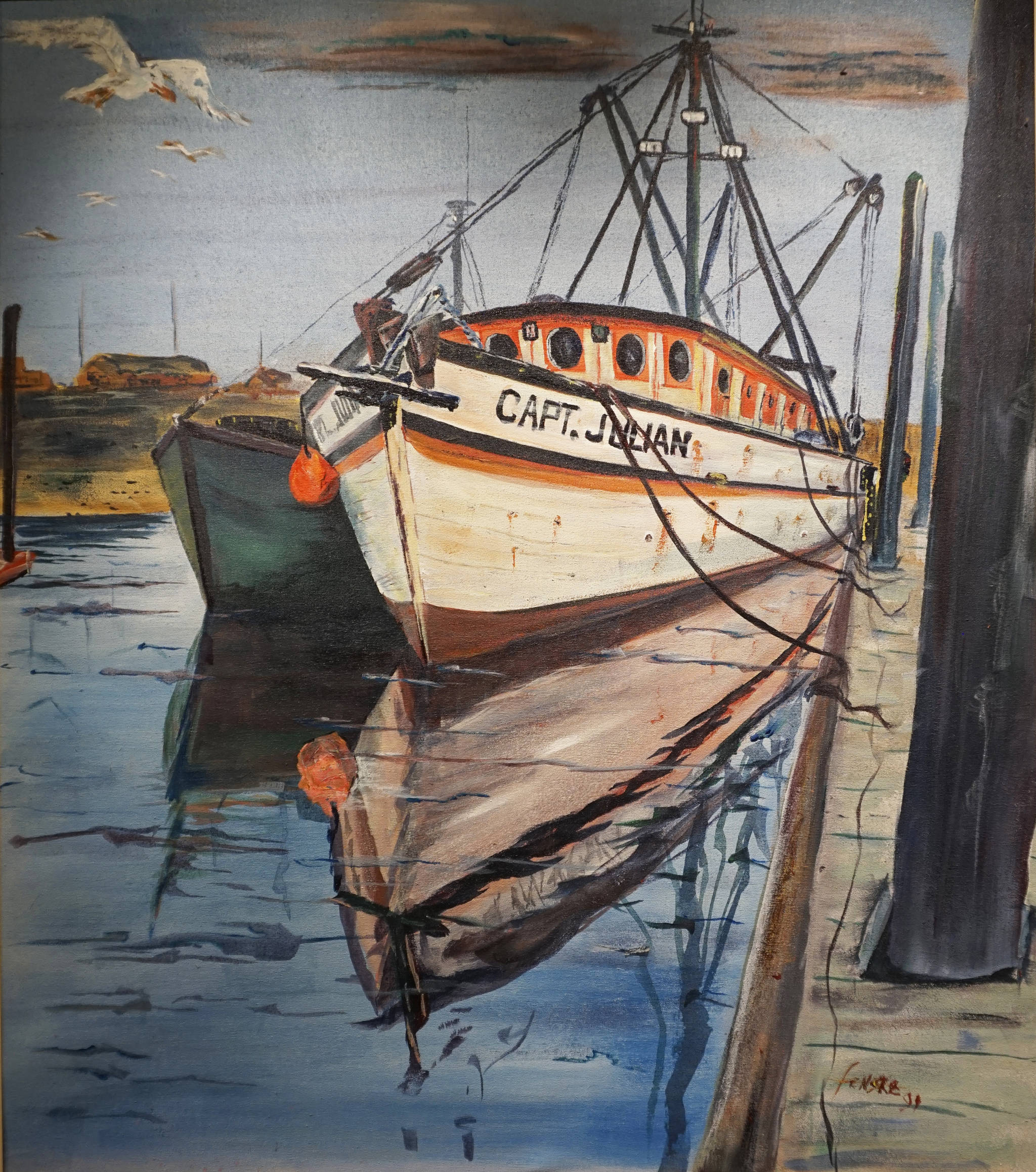Before former Homer City Council member — and, really, Renaissance man — John Fenske died Jan. 30, 2019, at the age of 77, he asked his family not to hold a memorial. A builder, pilot, welder, charter captain, politician, community leader and business owner, Fenske also left a legacy of his art.
Lots and lots of art.
So while Fenske didn’t want a memorial with lots of speechifying, he didn’t say anything about an art show. Organized by his friend Bill Smith and curated by Bunnell Street Arts Center Artistic Director Asia Freeman, “Knocking on Heaven’s Door” opened April 5 in the Pioneer Hall Commons gallery at Kachemak Bay Campus. It will remain on exhibit until next fall.
“I am unable to let the passing of a dear friend and remarkable individual go by unremarked,” Smith wrote in the program for the show. “Despite his request to family that no memorial be held, I observe he never made that request of me. Let John’s work stand in memorial.”
It’s fitting that Fenske’s oil paintings, pottery, carvings and whimsical rock people sculptures show at KBC. Fenske took numerous art classes at the college, completed his bachelor of science of psychology there and served as a KBC Advisory Board member for 32 years.
In a phone interview Tuesday, Smith said he thought of an art show as “a fitting way to memorialize him.”
Smith had served with Fenske on the college advisory board, and he knew the college did art shows, such as its annual student and faculty art exhibits. Smith contacted Freeman about being the curator.
“They had space,” Smith said of the college. “We had paintings. We had a curator. It came together rather nicely.”
When Freeman went to Fenske’s home to help pick out work for the show, she said he didn’t realize how much work he had.
“I didn’t know that his house would be full of paintings — under beds, behind cabinet doors, filling the walls,” she said. “That’s just stunning.”
Dina Marion, one of Fenske’s four children along with Kris Fenske, Kevin Smith and Craig Smith, said her dad only recently in life started hanging his work. One painting, “Crossing the Bar,” had hung on a sheltered porch for years.
“The show — it was amazing to see it somewhere besides his house,” Marion said. “Of course, Asia has such an amazing sparkle to it (the display). It was somewhat breath-taking going in there and saying, ‘Wow.’”
Smith said the hanging of the show went smoothly. After he and Freeman selected the paintings, last Wednesday he hung them at the college gallery to get them off the floor for a better look. He said Freeman came in while he was gone and “By the time I got there, she had it pretty much changed around. Everyone has their genius.”
“With that sort of work, it’s so colorful — you think it can go any which way,” Freeman said. “But then when you do start moving things around, you can see those relations. You can go big to small. … It’s a part that’s sort of like magic. I don’t know how it resolves itself. It’s like editing.”
Freeman described Fenske’s work as being in the Impressionist tradition. “Crossing the Bar” reminds her of the work of French Impressionist André Durain.
“It’s not a sedate place,” she said of the painting of boats plowing through heavy seas. “It’s not an image of a quiet, domesticated nature. It’s pushing at your edges, rubbing at your senses. It’s got your hairs standing up.”
Freeman remembered Fenske taking art classes with her mother, the painter Karla Freeman, and also artist Shirley Timmreck. While Fenske might have been typical of Homer lifelong learners who try new skills later in life, he went beyond that.
“He had a pretty remarkable level of ambition and productivity,” Freeman said. “Some people who want to learn to paint don’t have so much compulsion.”
Fenske also kept painting — and painting and painting.
“What’s also really interesting is he created so much work with so much humility,” Freeman said. “… He did it from a really pure place. I think it was passion. … I think he just had the ambition to become good, to become better. He wasn’t striving to find a market for his works.”
Despite his talent and skill, Fenske rarely showed his work. Freeman recalled one of his paintings appeared in a 1992 show at Bunnell curated by her mother, “Salon de Refusés,” a collection of works rejected by the juried Kenai Peninsula Art Show. Smith said Fenske also donated some paintings to the Oncology Center at Central Peninsula Hospital, Soldotna, where Fenske went for treatment.
Marion said Carol Swartz, the former KBC director, told her she suggested to Fenske that he have a show at the college, “and he poo-pooed the idea,” Marion said.
It wasn’t that Fenske was ashamed of his work.
“He looked at it as something he enjoyed and didn’t worry about somebody else enjoying it,” Marion said.
Marion said Fenske’s family is pleased with the exhibit.
“Bill — he took this on and really just ran with it,” she said. “That was so cool. What a gift to Dad as well as to the family, to see the response of people in the community I know Dad cared for in so many different ways.”
Freeman described the exhibit as “a little bigger than John in a way, but it’s filled with his energy,” she said.
“He was an amazing man: super, big hearted, dedicated to this community, overflowing with ideas. This is really a tribute to that.”
Reach Michael Armstrong at marmstrong@homernews.com.

